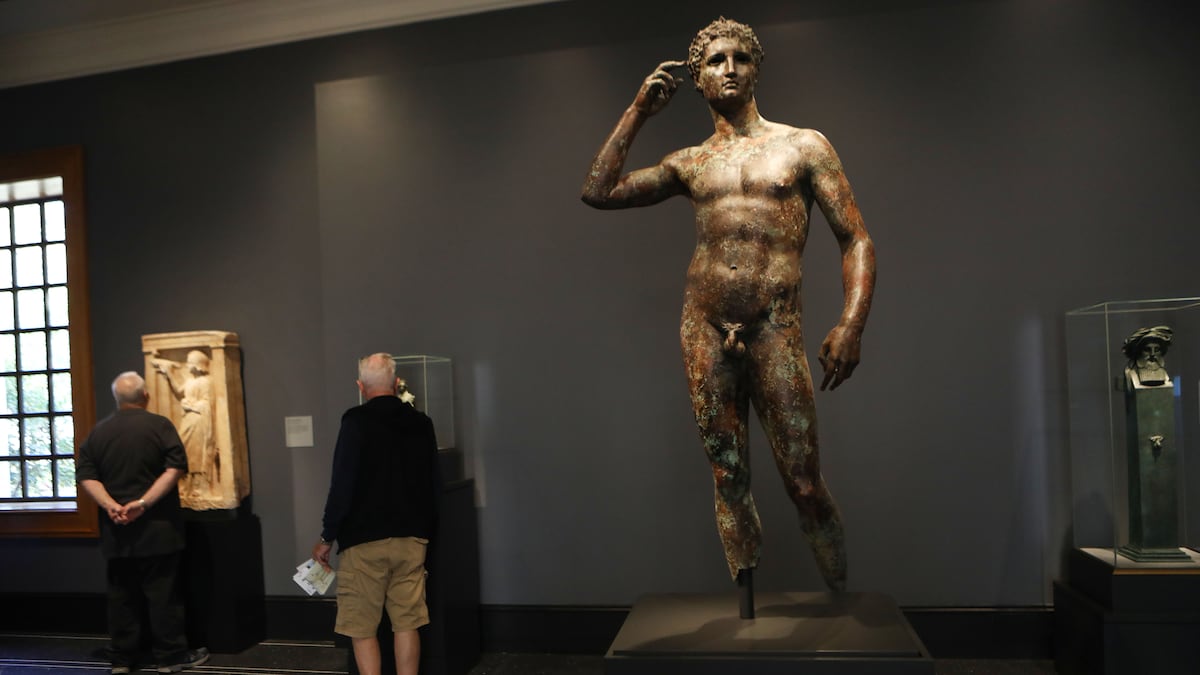He Victorious Athlete —o Fano athlete—, a bronze statue from the classical Greek period (300-100 BC) attributed by scholars to the artist Lysippus and exhibited in a California museum, has to return to Italy. After a very long and intense legal battle, the Strasbourg Human Rights Court ruled this Thursday that Italy has the right to confiscate the work – which represents a young athlete touching the olive wreath on his head with his right hand. , and which is one of the few life-size Greek bronze figures in the world—to the Villa Getty museum in Malibu, which also acted with “negligence” or “bad faith” when purchasing the piece, even though it knew that Italy was trying to recover it, say the European judges.
Rome, which long ago began a fight to recover looted property, assures that the Victorious Athlete It was smuggled out and sold illegally until it ended up in the hands of the fund that manages the American museum. This may be the end of the road for the statue, at the center of a much broader controversy over the restitution of historical heritage. However, Getty has hinted that he will appeal the ruling.
The statue of the Victorious Athlete was found by fishermen in 1964 in the Adriatic Sea, off the coast of Pedaso (Marche, Italy), sold a year later to an unknown person and auctioned in Munich (Germany) by a company based in Liechtenstein , as detailed in the European ruling. Two investigations were then opened in Italy, one for the receipt and handling of a stolen archaeological object belonging to the State, and another for illegal export. In 1977, the Getty Trust, which manages the art center, purchased the statue through a contract signed in the United Kingdom for $3.95 million. He Victorious Athlete He arrived at Villa Getty, north of Los Angeles, in March 1978.
After learning of the sale, the Italian authorities began the process to recover the piece, according to the ruling of the Strasbourg Court, through institutions, Interpol orders, several internal criminal investigations, a letter of request to the United Kingdom Government – where the statue passed through—and another letter of request to the US authorities. All without any results. He Victorious Athlete ended up at the Getty Villa.
The Italian Ministry of Cultural and Environmental Heritage then began a diplomatic journey with the United States Government, where it used the UNESCO convention on the means to prohibit and prevent illicit imports, exports and transfers of property – to which both are signatories. Italy like the United States. Although the statue was made part of a return agreement with other archaeological treasures, the Getty refused to return the piece, claiming that the alleged crimes had expired and that the Getty Trust had acted in good faith in purchasing the statue. In 2010, diplomatic efforts transformed into a judicial journey that ended in Strasbourg.
The Italian Minister of Culture, Gennaro Sangiuliano, has been “enormously happy” about the unanimous ruling of the Strasbourg Court, as published on his social networks. Sangiuliano has explained that he will formally request help from the United States – which is not part of the Strasbourg Court agreements – to confiscate the statue. His government, that of Giorgia Meloni, has increased legal and diplomatic efforts for the restitution of cultural heritage and threatens to suspend collaborations with museums that refuse to comply with restitution orders issued by Italian courts.
Getty, who appealed to the Court of Human Rights in 2019, has three months to appeal the ruling of the high European court. If he does not do so, the sentence will be final. “We believe that Getty’s public possession for nearly 50 years of a work of art that was neither created by an Italian artist nor found on Italian territory is appropriate, ethical, and consistent with U.S. and international law,” the institution said. in a statement in which he assures that he will follow the “appropriate” legal channels to defend that he has the right to keep the figure.
European judges assure that the statue is Italian not only because the insignia of the fishing boat that located it was Italian; but also because there has been a “continuity between Greek civilization, which had expanded into Italian territory, and the subsequent Roman cultural experience.”
“The Court has considered that the Italian authorities have reasonably demonstrated that the statue had formed part of the cultural heritage of Italy and had also legally belonged to the State when the Italian courts issued the confiscation order,” the Strasbourg court says in its ruling. The European judges detail in the ruling that Italy has the right to recover the piece under several international instruments to protect cultural property, stolen property and the return of cultural property illegally removed from a State. The list of laws and regulations that support confiscation and that includes the sentence is long.
